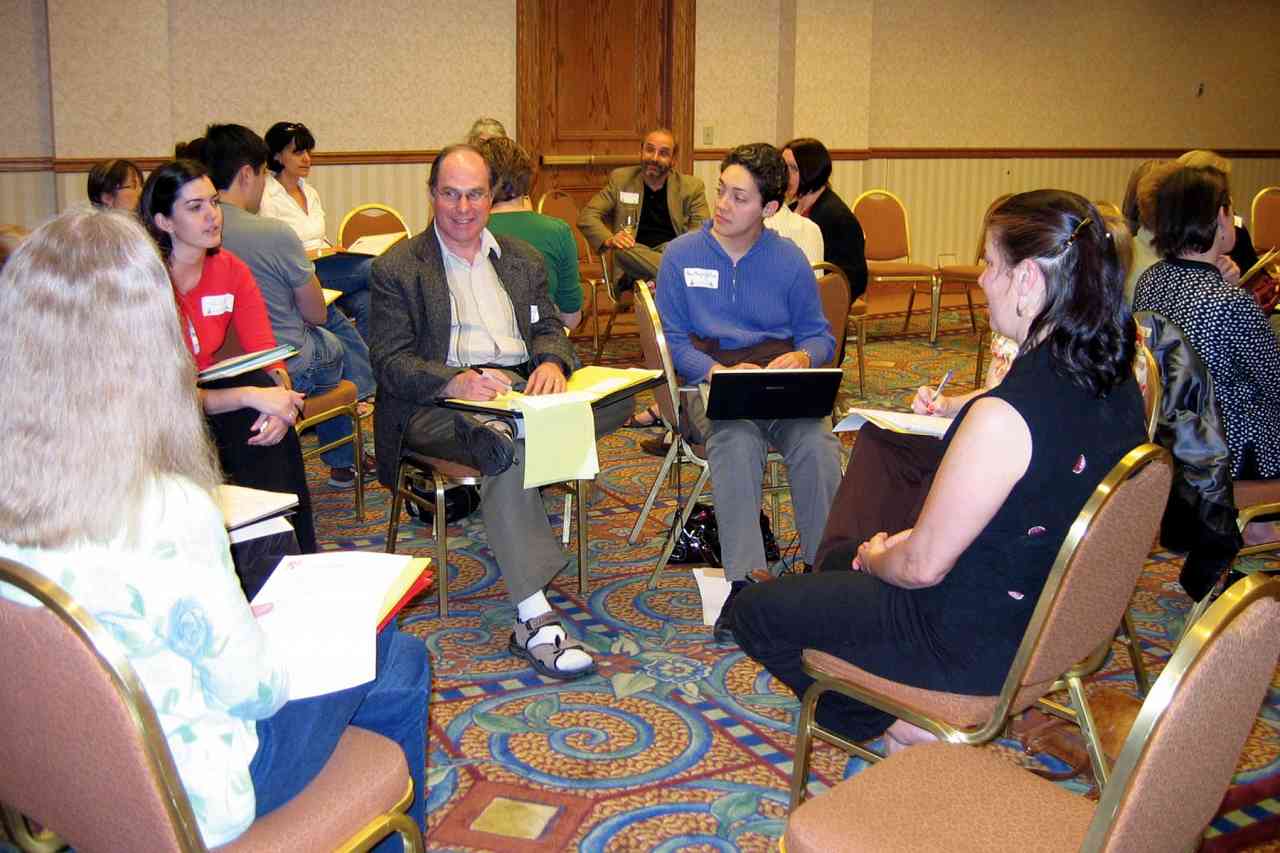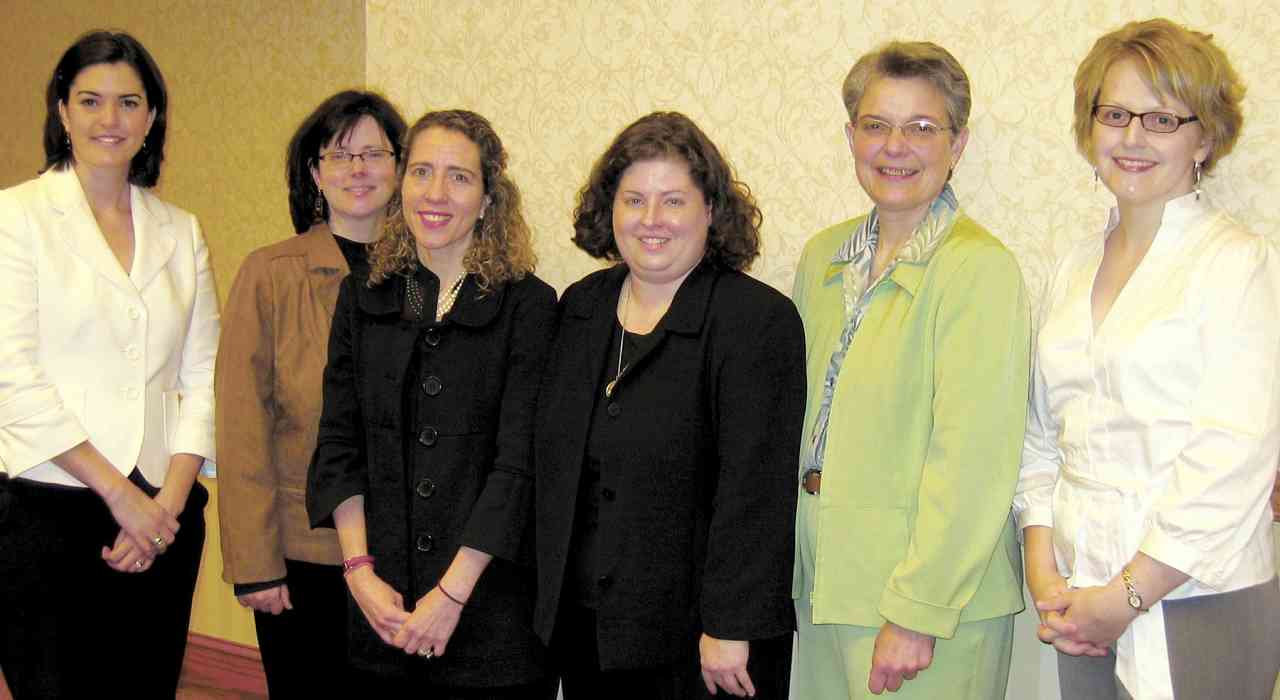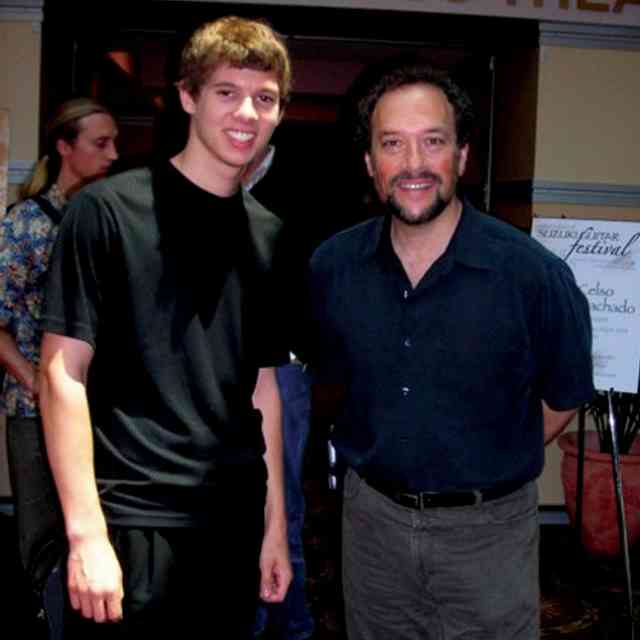
Suzuki teachers and parents, and many researchers gathered in Minneapolis May 22 and 23, 2008, to learn more about research and further the mission of the International Research Symposium on Talent Education. The number of participants at the Ninth IRSTE sessions has grown exponentially since the symposium became a pre-conference workshop at the previous IRSTE in 2006. At the ninth symposium we discussed research topics related to Talent Education and ways to develop research questions into projects. We discovered various ways to test crossing the mid-line, imitation in learning, and how sleep can affect learning and practicing for musicians. We also learned about a Suzuki program for at-risk students in New Jersey. Dr. Laurel Trainor, professor from McMaster University in Hamilton, Ontario, gave a keynote address presenting an overview of her research with babies and children learning music.
Pat D’Ercole and Dr. Alice Ann O’Neill, the co-coordinators of the International Research Symposium on Talent Education, arranged for Dr. Laurel Trainor to facilitate the group discussion and process of the symposium. Dr. Trainor is a developmental psychologist and researcher in the department of Psychology, Neuroscience and Behavior at McMaster University. One of the foremost scholars in research in music perception and cognition, she is the director of the McMaster Institute for Music and the Mind. Dr. Trainor is also a professional flautist and Suzuki parent.
Group Discussion and Process
During the group process Dr. Trainor reviewed the reasons for research regarding Suzuki education and various types of research methods. She focused on the experimental scientific research design of cause and effect with random assignment and control of variables. The participants were divided into groups for discussion of ways to choose variables and issues of experimental control when designing research projects. Several topics such as how to develop good tone quality and the effects of different types of practicing were chosen from the updated research agenda that was developed by the participants at the Eighth IRSTE in 2006. The group process participants, with the assistance of experienced researchers, discussed various facets involved with designing research projects. The session concluded with discussions of research over dinner.

Group discussion
Presentations of Current Research
Young Children Crossing Their Midline
Pat D’Ercole, a Suzuki violin teacher trainer from the Aber Suzuki Center at the University of Wisconsin-Stevens Point, was the first to present her research. In 2007, while a visiting scholar at the University of Texas at Austin, Pat developed into a project one of her research questions that had emerged from years of teaching and teacher training: the difficulty of young children learning to cross their midline. Entitled “Body Midline Crossing in Three to Six-Year-Old Children,” the study was carried out in Texas with children who had no violin training. Various tasks were designed to have the children cross their midline while touching articles or grasping items. The test results showed that the children in this study crossed their midline more often while seated when compared with standing and indicated that the ability to cross the midline improves with maturation. Pat D’Ercole’s research presentation was a fine example of a Suzuki teacher developing a research project based on her teaching experience and in search of better teaching tools to aid her students.
Models for Imitation with Violin Bowing
Melissa Becker, a doctoral fellow from the Center for Music and Learning at the University of Texas at Austin, presented a study which she co-designed with Drs. Laurie Scott and Robert Duke, professors at UT-Austin. This initial exploratory study, “The Influence of Multiple Models on Imitation Learning,” focused on tests that simulated violin bowing. The subjects participating in the study viewed modeling of violin bowing either by one individual or several different individuals. The data for this study was recorded after the modeling and over time to determine improvement of the skill learned. In this study the subjects who viewed multiple models tended to perform better, but in general the subjects in this study tended not to perform as well over time. This may be due to fatigue or because of the length of time between the modeling and the execution of the skill. This research design provides a framework for the evaluation of modeling and will assist with effective teaching and learning. This study indicated that multiple models while learning a skill may be more effective, and the practice of a particular skill performed soon after modeling seems more effective.
Piano Melodies Before and After Sleep
The study of Dr. Sarah Allen, a professor at Southern Methodist University in Dallas, Texas, was carried out at UT-Austin as doctoral research and was entitled “The Effects of Sleep, Interference, and Recall on Musicians’ Performance of Two Melodies.” Studies in various fields on memory consolidation for learning and the effect that periods of sleep can have on the appropriation of new skills have been completed in recent years. Dr. Allen reviewed and discussed several of these studies which included overnight sleep and targeted naps during the learning process. She also reviewed the stages of sleep and displayed several charts depicting learning curves.
Dr. Allen’s study evaluated the process of learning melodies using a piano and included a substantial number of experienced musician participants, all of whom were not pianists. Each participant played the piano melodies with their non-dominant hand and practiced during specified training sessions before evaluation of their skills. Retesting of playing skills occurred after overnight sleep. Some participants also learned a second melody to determine if this would interfere with the learning process of the primary piano melody. To briefly summarize Dr. Allen’s research results, the participants in this study who learned two melodies showed overnight gains in learning similar to the level found in the participants who learned only one melody and were evaluated before sleeping. The results showed that experienced learners performing a task, which requires auditory processing, benefit from overnight consolidation of procedural memories; however, with the initial test it seems there may be interference in the learning process when two similar competing tasks are learned together. Musicians can be comforted to know that we now have research which promotes some of the benefits of sleeping between practice sessions!
Suzuki Violin for At-Risk Students
Allen Lieb, a Suzuki violin teacher at the New York School for Strings, has been instrumental in forming a partnership between the New Jersey Symphony, the Newark school system, and Columbia University’s Teachers College to establish a modified Suzuki violin program in Newark, New Jersey, for at-risk, inner city students. Dr. Katherine Sinsabaugh, professor at Columbia and violist, presented current findings of the observations and preliminary data. The study, “Understanding How a Modified Suzuki Program Can Help At-Risk Students Succeed in Education,” is in its fourth of five phases of collecting qualitative and quantitative data at the schools primarily in the classroom. The research team has been challenged in collecting data from the students and their families due to the school environment, availability of family members, and language barriers. The research team is attempting to identify factors that coincide with previous findings from the New Jersey Early Strings violin program whose students are outperforming their peers on math and literacy standardized tests. Discipline and self-regulation seem to be emerging as factors of the effect of exposure of at-risk students to the Suzuki violin method and their achievement test scores. The Suzuki community will look forward to the conclusions from this study’s data collection, and wish success for their research project and the Newark modified Suzuki violin program.

Melissa Becker, Laurel Trainor, Katherine Sinsabaugh, Alice Ann O’Neill, Pat D’Ercole, and Sarah Allen
Keynote Address
Dr. Laurel Trainor’s keynote address was attended by nearly eighty people since it was open to both SAA conference and IRSTE participants. Dr. Trainor reviewed several studies that she had conducted at McMaster University in her session, “What Research Can Tell Us About How Children Learn Music.” The presentation included an overview of the recently founded McMaster Institute for Music and the Mind which integrates research in music education and science and involves a large group of interdisciplinary researchers. The McMaster Institute has three mandates: innovative research, inspiring education, and engaging the community. Suzuki flute teacher trainer, David Gerry, is currently working with Dr. Trainor on an extensive study of babies and music at the Institute.
Rhythm
Dr. Trainor reviewed a number of studies on babies and preschool aged children illustrating what has been discovered about how they process and learn about music. Two basic questions related to rhythm are “can infants discriminate meter?” and if they do, “does movement contribute to their perception of rhythm?” In one study an ambiguous rhythm pattern with no accents that could be interpreted as a march (duple meter) or a waltz (triple meter) was presented while infants were bounced either on every second beat or on every third beat. To measure the influence of the movement on whether the infant thought that the ambiguous rhythm was a march or a waltz, the study used the infant “preferential looking method.” Infants preferred to listen to a version of the rhythm accented to match how they were bounced, whether it was a march or a waltz. This indicates that babies can discriminate different metrical structures and that how babies are physically moved influences how they learn rhythmic patterns. For educators Dr. Trainor suggests that it is not enough just to watch movements to acquire knowledge of rhythm, but it is necessary to experience the movements to gain the maximum benefit of learning and understanding rhythm.
Pitch
Other studies concerned infants’ processing of pitch structure, particularly consonance and dissonance. One test included a Mozart piece as written and then with various notes altered by semitones to create dissonance. Infants preferred to listen to the original consonant version over the dissonant version. An additional study determined that babies are able to categorize consonant pitches from dissonant pitches. Dr. Trainor noted that it is well known that dissonant intervals set up interference vibration patterns on the basilar membrane in the inner ear whereas consonant intervals do not. Hence, it appears that musical pitch structure begins with consonance and dissonance. With regard to scales, Dr. Trainor presented studies showing that infants readily detect changes in a melody that go both outside the key and stay within the key, whereas older children and adults are much better at detecting changes that go outside the key compared with changes that stay within the key. This indicates that it takes considerable experience to develop sensitivity to scales. It takes even longer to develop sensitivity to harmony. But a preliminary study involving Suzuki students suggests that formal music lessons do accelerate sensitivity to harmonic structure.
Dr. Trainor concluded by discussing the relationship between music and other cognitive domains and the recent data linking superior performance on intelligence tests by children taking formal music lessons compared with those not taking lessons. She suggested that the cognitive advantages in music students are likely due to accelerated development of memory and attention. Using a Magnetoencephalography (MEG) brain imaging measure, she found that over the period of a year children taking music lessons showed a greater development of attention-related brain responses compared to those not taking music lessons. Dr. Trainor explained that formal music lessons likely have their effects on other cognitive domains by training memory and attention, thus mediating learning across many domains.
Summary
With the completion of any research study, it is usually determined that more study is necessary with a variance on tests or control groups and with replication for further depth of information and research. When the Ninth International Research Symposium on Talent Education was completed, it was evident how much more research is needed in our field. However, we acquired much information gathered through research, such as:
- the experimental scientific research design of cause and effect, with random assignment and control of variables;
- how young children cross their midline more often while seated when compared with standing, and the ability to cross the midline improves with maturation;
- that multiple models while learning a skill may be more effective than a single model, and the practice of a particular skill performed soon after modeling seems more effective;
- the benefit from overnight consolidation of procedural memories; however, there may be interference in the learning process when two similar competing tasks are learned together;
- how discipline and self-regulation seem to be emerging indicators or contributing factors in the exposure of at-risk students to the Suzuki violin method;
- how babies are able to categorize consonance from dissonance;
- how babies can discriminate different metrical structures, and ways they are physically moved influences how they learn rhythmic patterns;
- that it takes considerable experience to develop sensitivity to scales and even longer to develop sensitivity to harmony; and
- that formal music lessons likely have their effects on other cognitive domains by training memory and attention.
At the Ninth IRSTE we gathered to gain insights from research for effective teaching and learning, explored research techniques and methods, learned of new studies in our field and related fields, and we had opportunities to discuss research and new ideas. The research contributors for the symposium included Suzuki parents, violinists, cellists, pianists, early childhood music specialists and included the topic of Suzuki in the public schools. The mission of the International Research Symposium on Talent Education was furthered at the ninth symposium and continues to thrive twenty years after its inception. Helping Suzuki educators become more knowledgeable in research and involving more Suzuki educators in research efforts is essential to the future of our field of Talent Education. Dr. Suzuki, the first researcher of Talent Education, said, “Every day a new idea!” Consider turning your new ideas into research projects and participating in the Tenth International Research Symposium on Talent Education in 2010.








